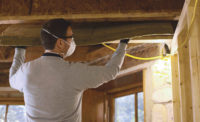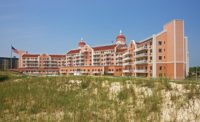Resilient Construction through Better Wall Design


A wall assembly cross-section, representing Sustainable.TO’s Toronto Wall method, incorporating two layers of stone wool rigid board insulation (ROCKWOOL COMFORTBOARD 80 exterior sheathing) to reduce thermal bridgingand increase energy-efficiency.

ROCKWOOL COMFORTBOARD 80 stone wool rigid board exterior sheathing provides a continuous layer of insulation around the entire building envelope.



Home builders frequently are asked to meet specific needs for individual clients. Recently, a client outlined their wishes by stating that they wanted a home that “would sip energy, endure for generations, and remain comfortable at all times.” No small task by any means, but a well-defined challenge for industry professionals.
Full-service sustainable architectural firm, Sustainable.TO Architecture + Building, and Greenbilt Homes, a highly regarded custom home builder, were engaged to design and build a leading edge, energy efficient and sustainable home that met the client’s wishes of creating a future-proof dwelling that could stand up to extreme weather events.
The home, known as the Risebrough Residence, required innovative design and high-performance building materials to achieve its air-tight, high-efficiency goals, along with careful collaboration between the architect and builder. As part of their design, the industry partners employed their Toronto Method Wall Assembly, a wall system conceived and tested to address the issues typically experienced with a code minimum wall in extreme climate where temperatures can reach 95 degrees Fahrenheit in the summer and -31 degrees Fahrenheit in the winter. These temperature variations are common throughout many regions of both Canada and the United States.
The team wanted to address the issue of condensation control, thermal bridging, air tightness and energy efficiency, all while using conventional, yet more sustainable building materials. The trouble with a code minimum wall is that it only considers that vapor drive is from the inside out. That’s fine in winter, because that’s what happening. However, when we cool our homes in the summer, the vapor drive is the other way around, so the polyethylene sheeting (vapor barrier) is in exactly the wrong place, allowing it to trap moisture as vapor cools and condenses on the poly sheet.
Assembly Details:
- 2 x 6 Framing
- 3.5” Interior Mineral Wool Insulation (ROCKWOOL Comfortbatt)
- Single air/vapor/weather barrier
- 6” of mineral wool rigid board insulation (ROCKWOOL Comfortboard 80)
- Insulation value: R-26
To avoid the issues with a code minimum wall, the Toronto Method Wall Assembly achieves a better building envelope by placing the right amount of materials, in the right place. It also embraces the easiest and lowest cost passive house measure, which is to first reduce the overall energy demand of the home. The team started with two-by-six framing which was then filled with 3.5 inches of ROCKWOOL ComfortBatt insulation. Stone wool insulation was used both inside and outside the home because of its high recycled and natural content, high R-value, vapor permeability, water repellency and fire resistance. Made of inert materials, stone wool also resists the growth of mold and mildew. Framing with 2 x 6 studs allowed all services such as plumbing and electrical to be installed inboard of the insulation. Outboard of the sheathing, the Toronto Method calls for a single, continuous, semi-permeable membrane for air, vapor and weather control to increase air tightness. In this case, Henry Company Blueskin VP100 was used. Following that, ROCKWOOL Comfortboard 80 rigid board provided continuous insulation around the home’s exterior, reducing thermal bridging almost completely. Two, three-inch layers of Comfortboard 80 were used for a total thickness of six inches. With a balance of two-thirds of the insulation on the outside of the home, and 1/3 on the inside, placement of a vapor retarder becomes unnecessary. Instead, the plywood sheathing acts as a vapor retarder, slowing transmission of vapor and allowing the wall system to dry to the inside and the outside per seasonal vapor drive in extreme climate. With a tight, but breathable, building envelope, the home’s energy demands are significantly reduced. The wall system is finished with wood strapping and lightweight cladding.
The Toronto Method Wall Assembly achieves the following:
- Almost completely reduces thermal bridging
- Prevents air leakage to a high degree, increasing energy efficiency (1.7 ACH @50 Pa)
- Eliminates the need for a 6mm polyethylene vapor barrier
- Allows the wall to dry to the inside or the outside, per seasonal vapor drive
- Uses sustainable, common & easily-sourced building materials in a more effective way to achieve a better performing building envelope.
To ensure goals were met, Sustainable.TO performed periodic site reviews to ensure construction proceeded as intended. A blower door test was performed to review the building envelope for air leakage to ensure a continuous air barrier. From a pre-inspection reading of 4.30 ACH50 (Air Change per Hour at 50 Pascals), Sustainable.TO was able to pinpoint air leakage, and improve air-tightness to a final reading of 1.7 ACH50—which translates to a 35 percent reduction in energy use from air-tightness alone.
The Toronto Method Wall Assembly, incorporating continuous exterior stone wool insulation, was one strategy used to realize greater efficiency. Along with a range of other passive house and energy efficiency measures, overall the Risebrough Residence was able to achieve 80 per cent greater efficiency than a conventionally built home.
Looking for a reprint of this article?
From high-res PDFs to custom plaques, order your copy today!










